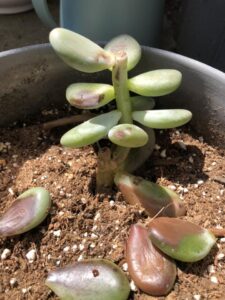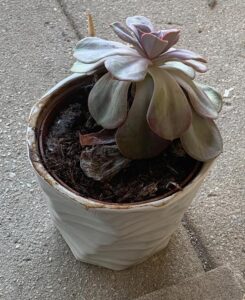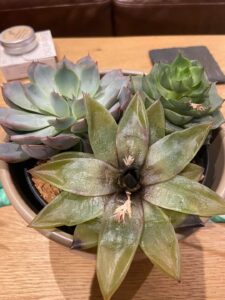Succulents are naturally resilient, low-maintenance, and drought-resistant plants. With those qualities growing them should be pretty easy, and you don’t need to work so hard to keep them alive, right? Well, these plants can indeed withstand harsh conditions, but they can also die.
Seeing your succulents dying is disheartening, especially if you love these stunning plants and want to see them healthy and looking splendid. So, I’m pretty sure you would like to know, why is my succulent dying?
Why Is My Succulent Dying?
There can be several reasons why a succulent might be dying. Here are some common factors to consider:
1. Overwatering
You may love your succulents so much that you end up killing them with too much water. Overwatering causes root rot which in turn deprives the plant of oxygen and causes the roots to decay.
Related Posts:
But how can you tell that you are watering your succulents excessively? Common signs include edema and yellowing leaves.
Note that succulents are adapted to survive in arid conditions, so they have low water requirements.
Also Read: How To Care For Succulents Indoors: A Beginner’s Guide
2. Underwatering
In an attempt not to overwater your succulents, you may end up underwatering them and depriving them of the much-needed moisture for survival. Sometimes you may not remember to water them.
Read More: How to water succulents
However, regardless of the reasons for underwatered succulents, the outcome is the same- the plant drying out and eventually withering.
3. Transplant shock
If you recently repotted or moved your succulent, it may experience transplant shock, which can lead to temporary wilting or decline. Provide the plant with proper care, including suitable light, water, and time to adjust to its new environment.
4. Lack Of Sunlight
With succulents commonly known as desert plants, it is safe to assume they love sunlight. Yes, this is true; these plants love bright light conditions, so planting yours in areas without enough sunlight will weaken them and eventually cause them to die.
Also Read: Succulents that are safe for cats and dogs
5. Excess Sunlight
Yes, succulents love sunlight, but the same way you would not want to soak in intense sunlight for long is the same for these plants. Succulents can suffer from sunburn, which causes brown spots or scorch marks on the leaves or turn the whole plant black.
The effects of excess sunlight are more severe in semi-succulent plants.
6. Poor soil drainage
Overwatering is not the only way to make the roots of your succulents rot. If the water doesn’t have a place to drain, it will accumulate, leaving the soil damp and with too much moisture. This is the sole reason to ensure you plant your succulents in containers with enough drainage holes.
Also Read: How to make your own succulent soil
7. Pests Or Diseases
Unless the signs are visible, I wouldn’t expect you to go with pests or diseases as the cause of your dying indoor succulents. However, this is a real possibility as succulents can be vulnerable to pests. Pests weaken the plants and cause them to decline.
8. Root-bound
Sure, the container your succulent is growing in is super cute and even stunning, but how practical is it? Does it have enough room for the roots to spread out comfortably? If the answers to these questions are no and your plants are dying, you are likely dealing with root bound.
Also Read: Easiest Succulents To Grow Indoors For Beginners
9. Insufficient Nutrients
As you already know, all living things need food to grow and thrive, so succulents need nutrient-rich soil to flourish. Therefore, a lack of nutrients can explain deformed or stunted growth in your succulent plants.
10. Poor Soil Mixing
Waterlogged roots and poor drainage, which are deadly to succulents, can stem from using the wrong soil mix to plant them.
What Does A Dying Succulent Look Like?
A dying succulent may exhibit several visible signs that indicate its declining health. Here are some common indicators to look out for:
a) Discoloration
You will automatically wonder whether it is dying once you see a color change in your succulents. Your dying succulent may develop yellow, brown, or black spots on its leaves or stems, with the discoloration being uniform or patchy, depending on the underlying cause.
b) Wilting And Shriveling
As your succulent continues to deteriorate, the leaves may begin losing their plumpness and become limp or shriveled. Also, those thick, fleshy leaves you love may appear deflated and show signs of wrinkling or curling inward.
c) Soft Or Mushy Texture
Are the stems or leaves of your succulent plants soft and mushy? While the squishy or spongy feeling may be pleasant, it also indicates overwatering and root rot.
d) Leaf Drop
Your succulent is struggling if its leaves start to fall off. This leaf shedding is a survival mechanism as the plant loses its leaves to save energy. Typically, gentle touch or movement will cause the leaves to fall off.
e) Slow Or Stunted Growth
As a succulent plant owner, monitoring its growth is your job, so when your succulents show minimal or no growth over time, they may be dying.
f) Foul Odor
Did you introduce succulents to your home to help purify the air, only for you to notice a foul smell coming from them? A dying succulent can smell unpleasant due to rotting roots or decaying tissues in severe decay or fungal infection.
Can You Revive A Dying Succulent?
Yes, you can revive a dying succulent, and after working hard to care for your succulent, being able to revive it is excellent news. Sadly, this isn’t always doable, with the chances of revival depending on the severity of the damage.
So, while I would applaud you for doing everything possible to save your dying succulents, there’s no shame in surrendering and starting over, mainly if they are beyond saving.
How Do You Save A Dying Succulent?
The reason you must spend some time finding out why your succulent is dying is that this information is key to saving the plant. So, knowing the culprit, follow these steps to revive your succulents.
1. Assess The Root Health
Taking out your succulent from the pot allows you to examine its root, so do it but carefully. Chances are you may notice rot signs, such as mushy or black roots. If that’s true, trim away the affected areas with sterile scissors or a knife, then allow the roots to dry for a day or two before repotting.
2. Adjust Watering
If you are dealing with a slightly overwatered succulent, shake its roots well, leave the plant in indirect, bright light for approximately a week, then replant it. On the other hand, if you underwatered your succulent, water it appropriately and make sure the water drains well too.
4. Check the Soil and Repot if Necessary
Ensure that the succulent is planted in well-draining soil. If the soil is compacted or retains too much moisture, repot the plant using a well-draining succulent or cactus potting mix. Gently remove the succulent from its current pot, shake off excess soil, and replant it in the new soil mixture.
5. Remove Dead or Rotting Parts
Trim away any dead or rotting leaves, stems, or roots using clean and sterile pruning shears. Removing these parts will prevent the spread of diseases and redirect the plant’s energy to healthier areas.
6. Adjust The Lighting Conditions
Succulents typically require bright, indirect sunlight. Therefore, if the lighting is your succulent plant’s issue, it is either receiving too little or too much, so the proper fix depends on the problem. Move your plant to a brighter spot or provide artificial grow lights if it is not receiving enough light.
On the other hand, if the plant is getting excess direct sunlight and is already sunburnt, remove the damaged leaves because they will not recover. After that, move it to a shadier area or provide shade in the afternoon.
7. Repot Your Root Bound Succulent
If you wish to revive a succulent dying due to root bound, repot it in a much larger container to give the roots ample room to spread. This approach also works if the current potting mix keeps excess moisture.
I recommend a pot or container that appeals to your style and preference, is large enough, and has drainage holes. Furthermore, choose a well-draining potting mix specifically formulated for succulents or cacti.
8. Eliminate Pests
Do not let your succulents succumb to pests and diseases, so take steps to eradicate them. Like most people today, I prefer using natural solutions like insecticidal soap or a neem oil solution to treat the plant and remove the pests, so consider them as well if you want an eco-friendly, safe method.
Also, carefully trim any rotting or blackened areas on the succulents using clean, sharp scissors or pruning shears. Do so to prevent the spread of disease or rot to the plants’ healthy parts.
9. Be Patient And Observe
Before embarking on the journey to revive your dying succulent, know that the plants will likely take several weeks or even months to recover fully. So, guess what? You must be patient and give the plant time to recover.
Furthermore, observe any new growth, color changes, or signs of improvement.
Can Succulents Grow After Dying?
Succulents cannot grow once they die because they would have exhausted their internal resources or suffered irreparable damage. Therefore, if you are dealing with such a plant, rest assured it will not recover independently.
However, there is some news; you can still salvage some parts of a dead succulent, such as healthy leaves or stems. If you succeed in rescuing these parts, you can propagate new plants from them by taking leaf cuttings or stem cuttings and providing them with the right conditions for rooting and growth.
Final Remarks
I hope you now know the primary causes of a dying succulent and can also take the necessary actions to rectify them and rescue the plant. If you catch the problem early, you will be in a better position to protect your succulent from irreparable damage and death.

Hey there, fellow plant enthusiasts! I’m Rachel, the green-thumbed writer behind Rooted In Garden. With a deep-rooted love for all things botanical, I’ve made it my mission to help you cultivate a thriving collection of houseplants. As a devoted plant parent myself, I understand the joys and challenges that come with nurturing these leafy wonders. Whether you’re a succulent aficionado, an orchid enthusiast, or simply adore all potted flora, join me on this journey as we explore the secrets to growing and caring for our beloved green companions. Together, let’s create a flourishing oasis indoors.



